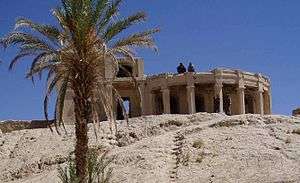Alexandria Prophthasia
Alexandria Prophthasia also known as Alexandria in Drangiana was one of the seventy-plus cities founded or renamed by Alexander the Great.[1]
The town was founded by Alexander the Great during an intermediate stop between Herat, the location of another of Alexander's fortresses, and Kandahar.[2][3] and is mentioned by Strabo,[4] Pliny,[5] Ammianus Marcellinus,[6] Isidore of Charax[7] and Pseudo-Plutarch[8]
Alexander the Great, arrived in Drangiana in November 330BC on his way to Kandahar, and found a well-organized province of the Achaemenid empire.[9][10] Alexander appointed a new satrap, Arsames, and renamed the capital city as Prophthasia, (Anticipation), because Alexander had here discovered a conspiracy against his life, organized by his companion Philotas.

The location of Prophthasia is currently unknown. Orthodox opinion is that Prophthasia was at Farah (also known as Phra)[11] and that the citadel of Farah holds the remains of his fortress. However, taking distances given in Pliny,[12] Eratosthenes and Strabo,[13] Tarn believes Farah is too close to the city of Herat and the city was actually at nearby Zaranj. Others feel it was located at Nād-e 'Alī.[14]
_-_Asiae-Tabula_IX.jpg)
The 1578 world map which Mercator constructed from Ptolemy's map shows the city some distance to the north of the Zaranji lakes.
References
- ↑ Edward James Rapson, The Cambridge History of India, Volume 1. 1955 Cambridge University Press. Page 380
- ↑ Caii Plinii secundi Naturalis historiae libri XXXVII interpretatione et notis illustravit Joannes Harduinus in usum Delphini Jean Hardouin, Pline l'Ancien, Hardouin page 698.
- ↑ Ralph Griffiths, George Edward Griffiths The Monthly Review May 1749-Sept. 1803 Page 514
- ↑ Strabo, 11.8 & 15.2.
- ↑ Pliny Naturalis Historia 6.61
- ↑ Ammianus Marcellinus 13.6.
- ↑ Isidore of Charax, Parthian Stations (Itinerarium) 17.
- ↑ Pseudo-Plutarch De Alex.
- ↑ Caii Plinii secundi Naturalis historiae libri XXXVII interpretatione et notis illustravit Joannes Harduinus in usum Delphini Jean Hardouin, Pline l'Ancien, Hardouin page 698.
- ↑ Ralph Griffiths, George Edward Griffiths The Monthly Review May 1749-Sept. 1803 Page 514
- ↑ Isidore of Charax, The Parthian Stations 17.
- ↑ Pliny XI 61.
- ↑ Strabo XI 514.
- ↑ Alexandria at Encyclopedia Iranica.com.